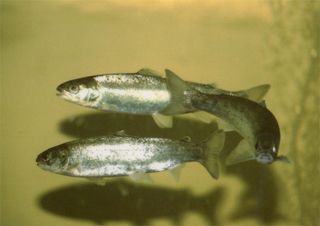New Clues to Where Salmon Go

Tiny transmitters attached to Atlantic salmon are helping to solve a mystery about their lengthy and sometimes fatal ocean treks and why the fish's population numbers are dropping.
Adult salmon are champion swimmers, often trekking more than 2,500 miles (4,000 km) from rivers to the ocean feeding grounds and back to these same rivers to reproduce. Once salmon hatchlings emerge from their eggs in freshwater rivers, they spend the first two to three years of their lives in that water before migrating to the ocean.
However, for every, say, 140 salmon that reach the ocean, only one fish returns to the river, said Mike Stokesbury, director of research for the Ocean Tracking Network (OTN), headquartered at Dalhousie University in Nova Scotia. "They know the fish are dying in the ocean, but they don't know where."
The transmitters showed that significant numbers of the fish are at least making it well into the sea, rather than dying as soon as they enter the ocean. About 30 percent of a tagged group migrated from a river in Maine at least 370 miles (600 km) in the ocean to a region off the coast of Halifax, Nova Scotia, on their way to feeding grounds off of Greenland.
"Salmon are an iconic fish, but they're becoming endangered and people want to know what's happening to the population," Stokesbury said. "This is the first step to finding out where in the ocean the salmon are dying and what's causing the decline."
For various reasons, including habitat destruction, dams blocking salmon runs and overfishing, wild salmon populations in the Atlantic have plummeted from more than 1.5 million in 1973 to an all-time low in 2001 of just over 400,000, according to the Atlantic Salmon Federation.
To learn more about their lifecycles, about 100 young salmon in the Penobscot River in Maine were tagged between May 8 and May 23 with acoustic transmitters by staffers with the National Oceanic and Atmospheric Administration (NOAA) and U.S. Geological Survey (USGS). Between June 10 and June 23, about 30 of the tagged salmon crossed a line of acoustic receivers deployed by OTN in the ocean waters off the coast of Halifax, Nova Scotia.
Sign up for the Live Science daily newsletter now
Get the world’s most fascinating discoveries delivered straight to your inbox.
The others either died along the way, snuck past the receivers undetected, or swam along routes not lined with the acoustic receivers.
"These were from the Penobscot River, which the U.S. government stocks every year," Stokesbury told LiveScience. “They have really high survival [in the river], but almost all of them die in the ocean."
So the tagged fish swam out of the Penobscot River on the Maine coast during the spring, entered the Atlantic Ocean, swam northeast along the coast of Nova Scotia and will continue north to the waters around Newfoundland and Labrador where they will spend the winter at sea south of Greenland.
The finding suggests "there's high survivorship at least as high as Halifax," Stokesbury said. "This mass mortality isn't happening in the Gulf of Maine at all."
The preliminary findings, announced this week, also showed the salmon are swift swimmers, booking about 1.5 to 2.5 body lengths per second. (The young fish are about 6 inches, or 15 cm, long.)
- Top 10 Most Incredible Animal Journeys
- Images: Endangered and Threatened Wildlife
- Video: Robotic Fish Work as a Team

Jeanna served as editor-in-chief of Live Science. Previously, she was an assistant editor at Scholastic's Science World magazine. Jeanna has an English degree from Salisbury University, a master's degree in biogeochemistry and environmental sciences from the University of Maryland, and a graduate science journalism degree from New York University. She has worked as a biologist in Florida, where she monitored wetlands and did field surveys for endangered species. She also received an ocean sciences journalism fellowship from Woods Hole Oceanographic Institution.
Most Popular



